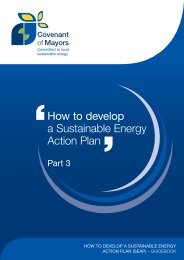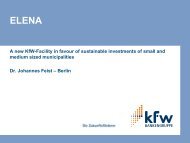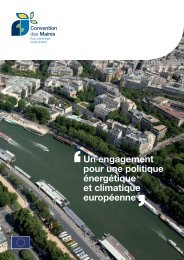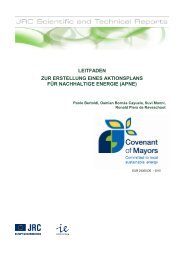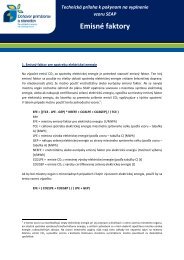English - Covenant of Mayors
English - Covenant of Mayors
English - Covenant of Mayors
You also want an ePaper? Increase the reach of your titles
YUMPU automatically turns print PDFs into web optimized ePapers that Google loves.
4.2.1 Buildings, equipment/facilities and<br />
industries<br />
1. Municipal buildings and equipment/facilities<br />
In principle, the local authority should be able to collect<br />
accurate and comprehensive energy consumption data<br />
related to its own buildings and facilities. Well-advanced<br />
local authorities already have a full energy accounting<br />
system in place. For other local authorities who have not<br />
yet initiated such a process, the energy data collection<br />
could require the following steps:<br />
• Identify all buildings and facilities owned/managed by<br />
the local authority.<br />
• Within those buildings and facilities, identify all energy<br />
delivery points (electricity, natural gas, heat from<br />
heating district network, fuel oil tanks, …).<br />
• For all those energy delivery points, identify the person/<br />
department receiving the invoices and energy data.<br />
• organise a centralised collection <strong>of</strong> these documents/<br />
data.<br />
• Select an appropriate system to store and manage the<br />
data (could be a simple Excel sheet or a more elaborate<br />
s<strong>of</strong>tware, available commercially).<br />
• Make sure the data are collected and introduced in the<br />
system at least every year. Tele measurement is possi ble<br />
and can ease the process <strong>of</strong> data collection.<br />
Note that this process <strong>of</strong> data collection may be the<br />
opportunity to deal with other important energy related<br />
issues:<br />
• Rationalise the number <strong>of</strong> energy delivery and invoicing<br />
points.<br />
• Renew/improve contractual arrangements with energy<br />
suppliers.<br />
• Initiate a real energy management process within the<br />
territory <strong>of</strong> the local authority: identify buildings which<br />
consume most energy and select them for priority<br />
action, such as daily/weekly/monthly monitoring <strong>of</strong><br />
energy consumption allowing to identify abnormalities<br />
and take immediate corrective action etc (see chapter<br />
8.1 in Part I <strong>of</strong> this guidebook).<br />
Renewable heat and cold produced and consumed locally<br />
by end-users should be measured and reported separately<br />
(columns related to ‘Renewable energies’ in Table A <strong>of</strong> the<br />
template).<br />
It is important that all fuel supplied for purposes <strong>of</strong><br />
producing electricity or district heating or cooling are<br />
tracked and reported separately as fuel used for electricity<br />
or district heating/cooling generation (Tables C and D <strong>of</strong><br />
the template).<br />
If the local authority buys green electricity <strong>of</strong> guaranteed<br />
origin, this will not affect its energy consumption, but it<br />
may be counted as a bonus to improve the CO 2<br />
emission<br />
factor (see Section 3.4.3). The quantity <strong>of</strong> such green<br />
electricity has to be derived from the supplier’s invoices,<br />
which indicate the origin <strong>of</strong> the electricity. The amount <strong>of</strong><br />
green electricity purchased has to be reported in Table A<br />
<strong>of</strong> the SEAP template.<br />
2. Municipal public lighting<br />
The local authority should be able to collect all data<br />
regarding Municipal public lighting. If it is not the case,<br />
an identification and data collection process similar to the<br />
one indicated in the previous paragraph may have to be<br />
initiated. In some cases, it may be necessary to place<br />
additional meters, for instance when an electricity supply<br />
point feeds both public lighting and building/facilities.<br />
Note: any non-municipal public lighting should be referred<br />
in the category ‘Tertiary (non municipal) buildings,<br />
equipment/facilities’.<br />
3. Other buildings and facilities<br />
This section covers:<br />
• tertiary (non municipal) buildings, equipment/facilities;<br />
• residential buildings;<br />
• industries (optional, excluding industry part <strong>of</strong> EU<br />
Emission trading scheme).<br />
19<br />
Regarding heating fuel oil or other energy carriers delivered<br />
periodically as bulk, it is <strong>of</strong>ten preferable to install<br />
a measurement device (gauge, metre, …) to help determine<br />
exactly the quantity <strong>of</strong> energy consumed during a given<br />
period. An alternative is to assume that the fuel purchased<br />
each year is equal to fuel consumed. This is a good<br />
assumption if the fuel tanks are filled at the same period<br />
each year, or if many deliveries <strong>of</strong> fuel occur each year.<br />
Collecting information from every individual energy<br />
consumer within the territory <strong>of</strong> the local authority is not<br />
always possible or practical. Therefore, a variety <strong>of</strong><br />
approaches are likely to be needed to develop an estimate<br />
<strong>of</strong> energy consumption. Several options are available, and<br />
<strong>of</strong>ten a combination <strong>of</strong> them is necessary to have an<br />
overall picture <strong>of</strong> the energy consumption within the<br />
territory <strong>of</strong> the local authority:




